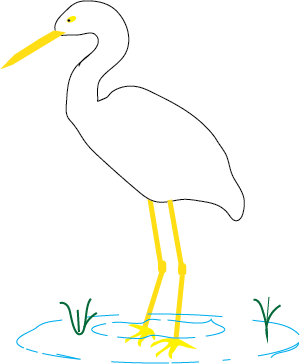Oliver Twist Unit Study
Follow Fagin and his shady allies as they relentlessly pursue the harmless orphan through the twisted back alleys of London. Our Oliver Twist Unit Study will make the characters and issues clear to your middle and high school students.
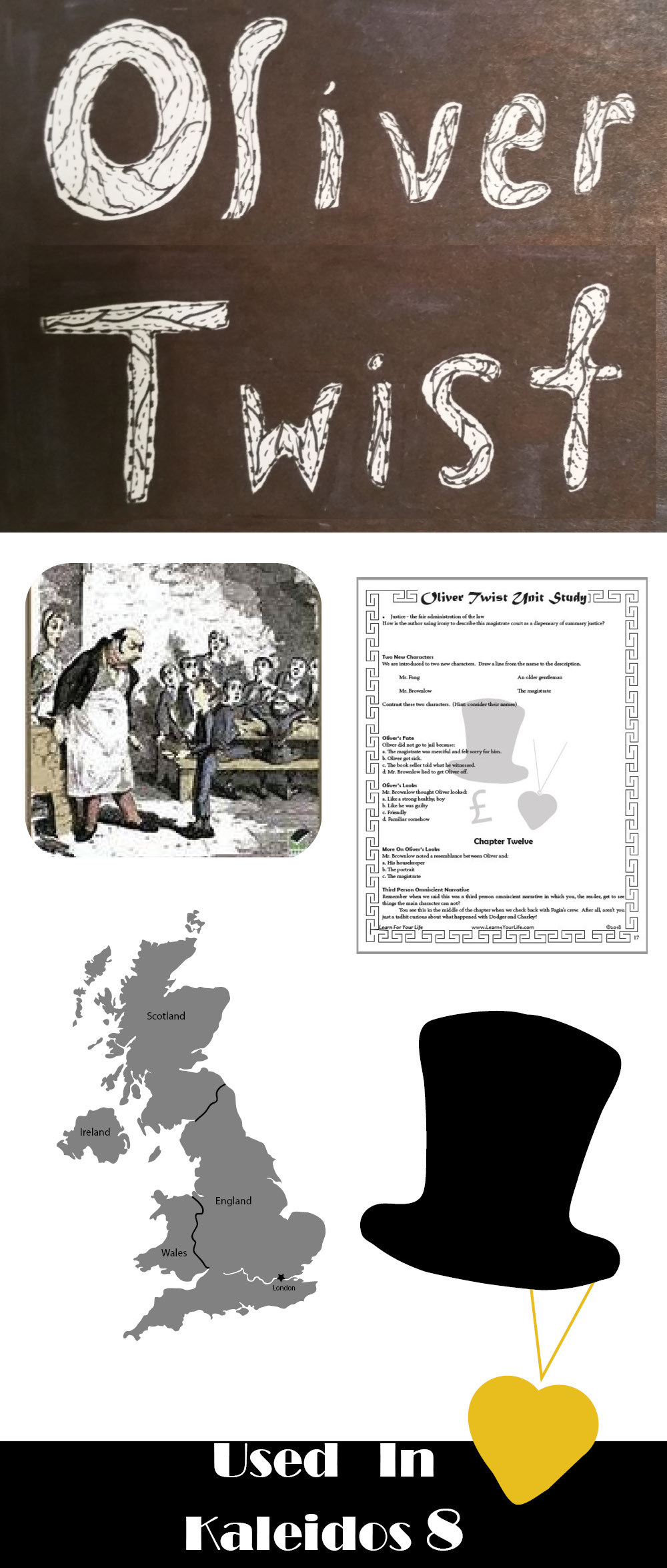
Buy The Oliver Twist Unit Study
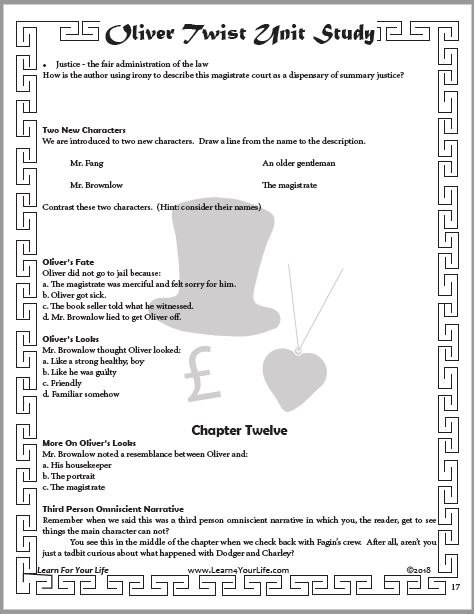
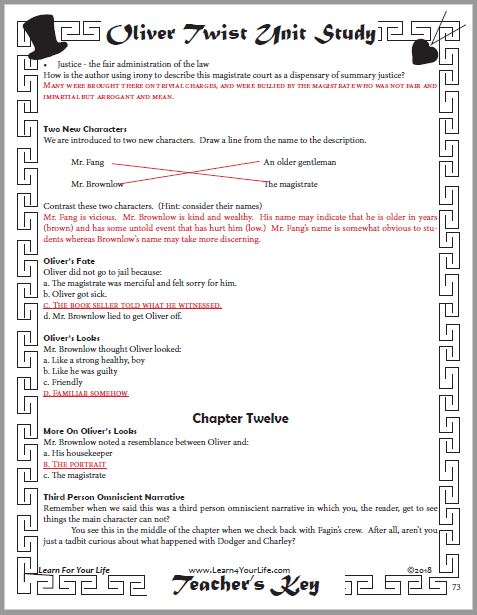
Student Guide AND Teacher's Answer Key Included
$2.99 Download - 108 pages
![]()
For Students and Teachers
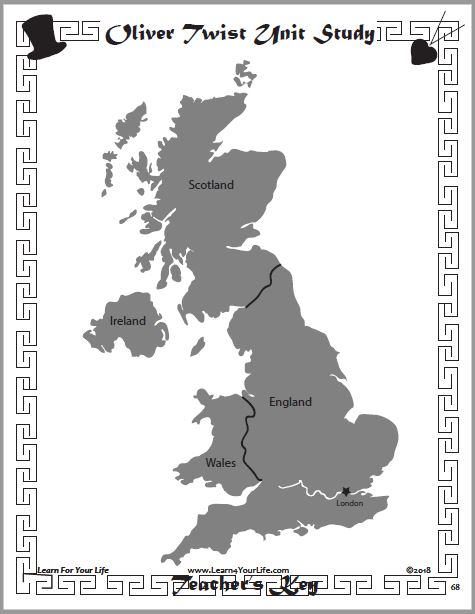
Students
Can be used by single students or a group.- Reading Help (particularly for some of the difficult passages)
- Vocabulary List with definitions
- Reading Comprehension and Pointer Questions
- Issues to Ponder, Discuss, and Debate
- Good to Know Information Boxes
- Test Taking Tips
- Writing Challenges
For Teachers
Literature discussion groups, classroom teachers, and homeschool parents will be ready to lead a dynamic unit with our Oliver Twist Unit Study Guide.- Teacher's Key with answers
- Geography (Map and suggestions)
- Group Activities
- Writing or Final Project Assignment Ideas
- Discussion Topics
Oliver Twist Vocabulary
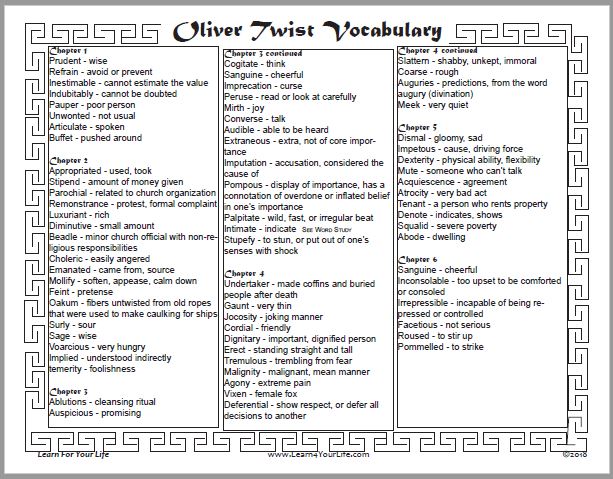
Chapter 1
- Prudent - wise
- Refrain - avoid or prevent
- Inestimable - cannot estimate the value
- Indubitably - cannot be doubted
- Pauper - poor person
- Unwonted - not usual
- Articulate - spoken
- Buffet - pushed around
Chapter 2
- Appropriated - used, took
- Stipend - amount of money given
- Parochial - related to church organization
- Remonstrance - protest, formal complaint
- Luxuriant - rich
- Diminutive - small amount
- Beadle - minor church official with non-religious responsibilities
- Choleric - easily angered
- Emanated - came from, source
- Mollify - soften, appease, calm down
- Feint - pretense
- Oakum - fibers untwisted from old ropes that were used to make caulking for ships
- Surly - sour
- Sage - wise
- Voarcious - very hungry
- Implied - understood indirectly
- temerity - foolishness
Go to Oliver Twist Vocabulary List page.
What Is In the Oliver Twist Unit Study?
Our chapter by chapter activities include a treasure trove of information.Pointer Questions
Our reading comprehension questions do more than check to see if the students read and understood the passage (though they do do that.) They point to the significant underlying events of the chapter.Students tend to read a book and follow primarily the action plot. Adults often do the same thing. They easily miss the subtle but more important phenomenon such as changes in characters' perspective, juxtaposition of contrasting themes, or foreshadowing events to come. The pointer questions point to those important elements within the chapters so students are focused on more than just the action.
To make the unit study more challenging, ask the question in the stem without giving the multiple choice answers. These make great discussion questions for a group as well.
In addition to asking questions, we also give some test taking strategies on how to answer questions.
Vocabulary Bookmarks
The vocabulary words are listed in the order they are encountered in each chapter. Definitions are included, so students can follow along and understand difficult passages as they read. For greater convenience, our vocabulary page can be folded in thirds which makes a great bookmarker.Reader's Help Sections
The Oliver Twist Unit Study includes 7 Reader's Help sections. There are a number of important passages in the book that are hard for modern readers to follow. It doesn't help that the first paragraphs of the book are one of those passages. You may very well lose students with lower reading comprehension skills or decreased interest in literature at the beginning.In the chapter to chapter activities, we let the students know at the beginning if there is a Reader's Help section. Then the actual explanation is put at the END of the chapter. Strong readers who don't want the assistance, can ignore it. Those who need the help, can find it.
Digging Deeper
Throughout the unit study, we have Good To Know sections which provide background information on subjects that are not as familiar to todays readers. These include: Poor houses and poor laws, apprenticeships, blood letting, pawn shops, British money and more.Suggested Activities
"Write a book report." How many times have students been given that unexciting assignment? Well, students have the opportunity to write far more exciting book reports with our "Look For" hints on the first page with accompanying thesis statements. At the end of the book and unit study, other possible themes for a paper are listed.Using these (or other) angles, students can write a cohesive paper, or do another type of project such as art project or oral presentation.
Hands-On Activities
Stir up some action with a few other suggested activities tied to specific chapters. These include:- Playing the famous game Oliver had to learn while staying with Mr. Brownlow
- Charades of different characters in the book
- Mini Mock Trial
- A Mock Pawn Shop Swap
Geography In Oliver Twist
Maps always help us understand a story. Our Oliver Twist Unit Study provides three geographic helps.London and the River Thames: This bit of world geography is well-known to those living in England, but not everyone knows exactly where the famous river is located.
History of London Bridge: It was more than just a nursery song. The antiquated version of the crumbling bridge was the one where Rose and Nancy met. But it actually was replaced prior to Oliver Twist's publication.
Jacob's Island: An exotic destination for aristocratic vacations? No, this was the worst slum in a city full of slums.
Literary Elements
Use the Kaleidos Treasure Map to highlight the significance of literary elements. Those specifically covered in this book include:- Round and flat characters
- Third person omniscient vs limited
- Parts of the Action Plot
- Mood
- Themes
- Dialect
- Sarcasm
- Inference
- Irony
- Litotes
- Foreshadowing
- Threads
- Juxtaposition
Model Sentences
Dickens is a great writer; there's no doubt of that. Throughout the Oliver Twist Unit Study, model sentences are presented to the student for analysis. Exactly what did Dickens do to make such bold and daring sentences.Super Writer Challenges are issued to students to use the model sentence to improve their own descriptive writing.
Word Study
Our word study sections strengthen reading and writing skills. They include:- Analysis of certain phrases (such as "might and main")
- Connotation and Denotation of some words (such as "invaluable")
- Changing words from one part of speech to another (such as changing an adjective to noun with "ity" in "rapidity")
Unique Features of Oliver Twist
Charles Dickens masterfully employed many of the literary elements mentioned above to make a good story a great story. But he also wove into the tale unique features that helped cement Oliver Twist's place in literary history. Here are some of the features explored in our Oliver Twist Unit Study:- Social Issues - stories with prostitutes, criminals, and murder were not common place in Victorian England.
- Parallels with Charles Dicken's own life
- Philosophy - Dickens uses the word "philosophy" in a rather twisted way. Students are challenged to look for his perspective.
- Names of his characters - his names are intentional, particularly Oliver's last name
Criticisms of the Book Oliver Twist
Finally, four critiques of Oliver Twist are examined at the end of the unit study:- Racism and stereotyping - addressed throughout the unit
- Oliver's role (or lack of role) in the book in which he is supposed to be the main character
- Unrealistic coincidences throughout the story
- Cinderella-like ending for Oliver without addressing solutions to the social issues raised in the book
Buy The Oliver Twist Unit Study


Student Guide AND Teacher's Answer Key Included
$2.99 Download - 108 pages
![]()
Oliver Twist and Jacob's Island
For those interested in the fascinating history of Jacob's Island - (where Bill Sikes meets his downfall) - see our article about Oliver Twist and Jacob's Island. The actual house intended by Charles Dickens was identified in 1855.


